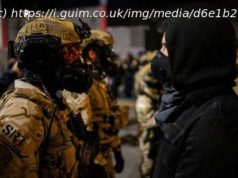There’s not much empirical weight behind the ban, although experts say it could reduce mass shooting deaths.
Last week, a shooter at Santa Fe High School in Texas killed 10 people and injured 10 more — in just the latest example of a mass shooting in America. But unlike so many of the other shootings that have gained national attention, the gunman in this case did not use an AR-15 or what’s typically considered an assault weapon. Instead, he used a handgun and shotgun.
But here’s the thing: When it comes to shootings in America, the use of other weapons — particularly, a handgun — is actually typical. Shootings with rifles, including assault rifles, make up less than 3 percent of gun homicides in the US. And according to federal data, handguns have over the past couple decades made up the great majority — more than 70 percent — of firearms used in homicides.
The data, along with the tragedy in Santa Fe, shows the limitations of an assault weapons ban, which has become one of the top policy proposals from March for Our Lives and other gun control advocates — despite also being one of the gun control measures with the least supportive evidence behind it.
The typical argument for the ban: Weapons of war have no place in American communities. These high-velocity, high-capacity weapons are particularly deadly, even more so than other semiautomatic firearms such as handguns. They have also been used disproportionately in mass shootings. And they aren’t needed for hunting or self-defense. So they should be banned altogether.
All these claims have a certain intuitive sense behind them. What they don’t have, however, is a whole lot of empirical evidence, based on my discussions with gun policy experts and researchers. Studies on assault weapons bans have generally ranged from inconclusive to unfavorable toward a ban. And even if the bans were effective at constricting access to assault weapons, they would likely have only a small effect on gun violence overall.
That doesn’t mean an assault weapons ban would have absolutely no effect. Consider the 2017 mass shooting in Las Vegas. In that case, the gunman parked himself on the 32nd floor of a hotel near a country music concert and fired indiscriminately into the crowd with assault weapons — which were also retooled with bump stocks to mimic the firepower of machine guns. He killed 58 people and injured hundreds.
Bump stock or not, it stands to reason that the shooting would have been much less lethal if the shooter didn’t use an assault weapon and used, say, a more conventional handgun instead. The bullets would have had shorter range, and those that hit would have had lower velocity and therefore caused less damage. In a shooting with such a high casualty count, that could’ve translated to potentially hundreds of injuries averted — although the shooter also could have changed his approach without access to assault weapons.
Still, it’s worth putting this in context: This kind of violence is already relatively infrequent. Rifles are very rarely used in homicides, and mass shooting deaths make up less than 4 percent of gun homicides in the US. So, again, pushing assault weapons out of circulation wouldn’t have a big impact on overall gun violence in America, even if it has some impact on some particularly awful tragedies.
These are just some of the complications that limit an assault weapons ban’s effectiveness. So while the policy may seem intuitive, there isn’t much evidence to support it — and in a world with limited political capital for gun reforms, those gaps in the research need to be taken seriously.
The most cited review of the evidence is a 2013 analysis by researcher Christopher Koper on the effect of the 1994 federal assault weapons ban, which lawmakers let expire in 2004.
The analysis concluded, “The ban did not appear to affect gun crime during the time it was in effect, but some evidence suggests it may have modestly reduced gunshot victimizations had it remained in place for a longer period.”
That was partially, Koper wrote, because the 1994 ban was riddled with loopholes.
To understand why, consider a surprisingly tricky question in this discussion: What is an assault weapon, and how do you define it? For lawmakers, these questions have posed a challenge over the years.
People might have a vision of an assault weapon in their heads — say, a semiautomatic rifle like an AR-15 — but defining what makes that an assault weapon can be difficult. Is it that it’s semiautomatic? Well, there are semiautomatic handguns and hunting rifles too. Is it the high velocity and long range? Traditional hunting rifles can also have those features. Is it the pistol grip? That offers an easy way around the law then — if someone could just remove a pistol grip, then it’s no longer an illegal assault weapon.
Ultimately, the 1994 ban settled on a definition of assault weapons that included, among other features, “pistol grips on rifles, flash hiders, folding rifle stocks, threaded barrels for attaching silencers, and the ability to accept ammunition magazines holding large numbers of bullets,” as well as some specific guns by name and “copies or duplicates” of them, Koper wrote. That captured some handguns, on top of the rifles that people might typically think of as assault weapons.
But the ban was still easily bypassed, Koper noted: “Relatively cosmetic changes, such as removing a flash hider or bayonet mount, were thus sufficient to transform a banned weapon into a legal substitute. In this sense, the law is perhaps best understood not as a gun ban but as a law that restricted weapon accessories.” Gun manufacturers took advantage of this, producing modified versions of previous weapons to make them legal — blowing a big hole in the law.
Plus, guns made and owned prior to the ban were grandfathered in, making them legal to own and transfer. That comprised at least 1.5 million assault weapons in the US at the start of the ban, according to Koper.
This gets into another tricky aspect of banning assault weapons: Do past guns get to stay around, or are there efforts to take those out of circulation through, for instance, a buyback program or a mandatory registration-and-tax scheme (similar to current laws for automatic weapons)? The 1994 ban took the former approach, but March for Our Lives has called for the latter with a new ban.
The 1994 ban was also attached to a ban on high-capacity magazines that carried more than 10 rounds, which Koper suggested was arguably the law’s “most important provision.” That’s in part because this ban also affected the firearms that weren’t covered by the assault weapons ban, so it could affect a much broader level of gun violence. Indeed, a study from February by Koper suggested that high-capacity magazines may be involved more often in typical shooting deaths than previously thought.
But at the end of the day, Koper found that the 1994 ban had no significant effect on gun crime — although it may have had some modest effects if it had been allowed to stay around for longer and over time pushed more assault weapons and high-capacity magazines out of circulation.
Koper’s analysis had two big gaps: It didn’t look at the 1994 ban’s effect on mass shootings, and it didn’t analyze state laws.
For that, the best review of the evidence is an extensive report by the RAND Corporation released in March, which looked at US studies on gun control, including assault weapons bans at the state level.
Here, too, the news is not good for an assault weapons ban. RAND found that the available studies were often contradictory. Focusing specifically on the most rigorous studies, RAND found the evidence for bans’ effects on assault weapons and high-capacity magazines on mass shootings and violent crime in general to be “inconclusive.”
“None of [the studies] provided what we considered to be any kind of conclusive evidence,” Andrew Morral, the head of RAND’s gun policy initiative, told me.
“The studies are pretty weak,” Morral said. “Also, a lot of these bans have been pretty weak” — noting many of the same loopholes that the Koper analysis did.
But what if an assault weapons ban wasn’t weak — and really took these guns out of circulation? The US could, for example, follow Australia’s lead and ban a much broader category of semiautomatic rifles and institute a mandatory buyback program — basically, a firearm confiscation scheme. Would that have a significant effect?
Experts said that even a more effective ban on assault weapons likely wouldn’t have much of an impact on overall gun violence in the US.
That’s because only a small percentage of overall gun violence involves assault weapons, with the great majority of firearm homicides involving more conventional handguns. And Morral said there’s no reason to believe an assault weapons ban would have any effect on suicides, which have in recent years made up around 60 percent of all gun deaths.
In a country with so many gun deaths, cutting even a percentage point or two of overall gun deaths could still save hundreds of lives a year. But in terms of addressing America’s overall gun problem, it just wouldn’t have a big impact.
Still, experts said that an assault weapons ban may have a significant effect on the lethality of mass shootings.
Assault weapons’ “functionality is really most relevant in the context of a public mass shooting,” Daniel Webster, the director at the Johns Hopkins Center for Gun Policy and Research, told me.
Start
United States
USA — Criminal The Santa Fe High School shooting shows why an assault weapons ban...






